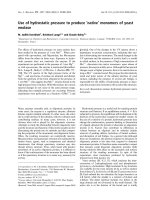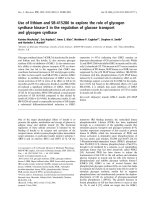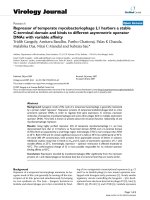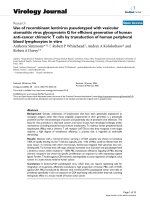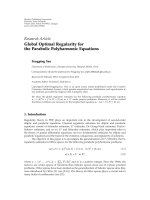Báo cáo sinh học: "Use of sib-pair linkage methods for the estimation of the genetic variance at a quantitative trait locus" pps
Bạn đang xem bản rút gọn của tài liệu. Xem và tải ngay bản đầy đủ của tài liệu tại đây (776.38 KB, 14 trang )
Original
article
Use
of
sib-pair
linkage
methods
for
the
estimation
of
the
genetic
variance
at
a
quantitative
trait
locus
H
Hamann,
KU
Götz
Bayerische
Landesanstalt
f3r
Tierzv,cht,
Prof
Diirrwaechter-Platz
1,
85586
Grub,
Germany
(Received
26
August
1994;
accepted
19
November
1994)
Summary -
Until
recently,
the
sib-pair
linkage
method
of
Haseman
and
Elston
could
only
be
used
for
the
detection
of
linkage
between
a
quantitative
trait
locus
(QTL)
and
a
marker
locus.
It
was
not
possible
to
estimate
the
amount
of
genetic
variance
contributed
by
the
QTL
or
its
recombination
fraction
with
the
marker
locus.
With
the
advent
of
dense
marker
maps
for
nearly
every
domestic
species,
every
QTL
should
be
located
between
2
flanking
markers.
In
this
situation,
the
Haseman-Elston
test
can
be
modified
to
estimate
the
variance
of
a
putative
QTL
as
well
as
its
recombination
fractions
with
the
2
flanking
markers.
In
the
present
paper,
we
derive
2
different
estimation
methods
for
the
QTL
variance
based
on
the
squared
performance
of
full
sibs:
in
one
only
the
QTL
variance
is
estimated,
while
in
the
other
both
the
QTL
variance
and
the
recombination
fractions
are
estimated.
The
method
that
estimates
only
the
QTL
variance
turns
out
to
be
more
powerful
than
the
other.
With
respect
to
the
estimation
of
QTL
variance
both
methods
give
results
close
to
the
true
values.
However,
the
estimation
of
recombination
fractions
resulted
in
an
overall
underestimation
of
the
true
parameters.
sib-pair
linkage
/
quantitative
trait
locus
/
genetic
marker
/
genetic
variance
/
recombination
fraction
*
Correspondence
and
reprints
Résumé -
Emploi
des
méthodes
d’évaluation
des
liaisons
génétiques
par
les
couples
de
germains
pour
estimer
la
variance
génétique
à
un
locus
de
caractère
quantitatif.
Jusqu’à
une
période
récente,
le
test
de
liaison
génétique
de
Haseman
et
Elston,
basé
sur
les
couples
de
germains,
ne
pouvait
être
utilisé
que
pour
la
mise
en
évidence
de
liaisons
entre
un
locus
à
effet
quantitatif
(QTL)
et
un
locus
marqueur.
Il
n’était
pas
possible
d’estimer
la
part
de
la
variance
génétique
totale
liée
au
QTL,
ni
le
tau!
de
recombinaison
avec
le
locus
marqueur.
Suite
au
développement
de
cartes
denses
dans
la
plupart
des
espèces
d’élevage
domestiques,
chaque
QTL
est
susceptible
d’être
localisé
entre
2
locus
marqueurs
flanquants.
Dans
cette
situation,
le
test
de
Haseman-Elston
peut
être
modifié
pour
estimer
à
la fois
la
variance
du
QTL
et
les
taux
de
recombinaison
avec
chacun
des
locus
marqueurs
flanquants.
Dans
le
présent
article,
2 méthodes
d’estimation
de
la
variance
du
QTL
basées
sur
les
différences
quadratiques
des
performances
des
germains
sont
développées :
l’une
n’estime
que
la
variance
du
QTL,
en
revanche
l’autre
estime
la
variance
du
QTL
et
les
2
taux
de
recombinaison.
Une
étude
de
simulation
permettant
d’apprécier
la
puissance
et
la
qualité
des
2 méthodes
d’estimation
est
présentée.
La
méthode
permettant
d’estimer
la
variance
du
QTL
uniquement
apparaît plus
puissante
que
la
seconde.
Chaque
méthode
donne
des
résultats
assez
proches
des
vraies
valeurs
en
ce
qui
concerne
la
variance
du
QTL.
Les
taux
de
recombinaison
sont
en
revanche
globalement
sous-estimés.
liaison
génétique
par
couples
de
germains
/
locus
de
caractère
quantitatif
/
marqueur
génétique
/
variance
génétique
/
taux
de
recombinaison
INTRODUCTION
Haseman
and
Elston
(1972)
developed
the
idea
of
detecting
linkage
between
a
genetic
marker
and
a
quantitative
trait
locus
(QTL)
by
examining
the
squared
difference
of
the
performance
of
full-sibs.
Other
studies
(Blackwelder
and
Elston,
1982;
Amos
and
Elston,
1989)
showed
that
the
method
is
robust
against
a
variety
of
distributions
of
the
trait
examined
and
that
it
can
also
make
use
of
multivariate
data
(Amos
et
al,
1989).
G6tz
and
Ollivier
(1992)
found
that
in
animal
populations,
especially
in
pigs,
the
power
of
the
method
is
at
least
comparable
to
that
of
methods
based
on
the
analysis
of
variance.
However,
the
Haseman-Elston
method
in
its
original
form
could
only
detect
linkage
between
a
marker
and
a
QTL,
but
could
not
estimate
whether
this
was
due
to
a
QTL
with
large
effect
at
a
large
distance,
or
to
a
QTL
with
small
effect
that
is
closely
linked
to
the
marker.
Studies
for
the
establishment
of
a
complete
linkage
map
of
the
pig
genome
are
under
way
(Anderson
et
al,
1993;
Rohrer
et
al,
1994).
This
will
lead
to
the
situation
that
in
the
near
future
every
QTL
of
economic
importance
will
be
in
the
vicinity
of
2
flanking
markers.
This
article
will
show
how
sib-pair
linkage
tests
can
be
applied
for
the
estimation
of
the
variance
caused
by
a
QTL
located
between
2
flanking
markers.
A
simulation
study
will
be
presented
to
examine
the
power
and
properties
of the
method.
MATERIALS
AND
METHODS
Theory
Haseman
and
Elston’s
test
(1972)
is
based
on
the
idea that
the
difference
in
the
performance
of
full-sibs
becomes
smaller
if
the
sibs
share
a
larger
proportion
of
alleles
identical
by
descent
(ibd)
at
a
QTL
with
large
effect.
Elston
(1990)
gives
a
general
description
of
the
method
that
will
only
briefly
be
outlined
here
for
the
simplified
case
of
a
QTL
with
no
dominance.
The
basic
variable of
the
Haseman-
Elston
test
is
the
squared
difference
(Y
j)
between
2
sibs
(1
and
2)
within
a
family
j:
Given
the
proportion
of
genes
ibd
at
the
QTL
(!r!t),
Elston
(1990)
shows
that
the
expectation
of
Yj
is:
where
a’
is
the
additive
genetic
variance
due
to
the
QTL
and
ae
the
variance
of
the
difference
of
all
other
genetic
environmental
components.
Since
the
proportion
of
genes
ibd
at
the
QTL
cannot
be
observed,
the
proportion
of
genes
ibd
at
the
linked
marker
locus
(7rj
m)
must
be
used
to
estimate
7r
jt
.
The
expectation
of
Yj
given
!r!!
is:
where
B is
the
recombination
frequency
between
QTL
and
marker
locus.
This
is
a
general
linear
regression
equation
and
can
be
written
as:
The
expectation
of
the
regression
coefficient
is:
where
b
is
an
estimator
of
!3.
This
expectation
is
zero
if
either
Q9
is
zero
or
0
is
equal
to
0.5.
Blackwelder
and
Elston
(1982)
showed
that
the
distribution
of
the
estimated
regression
coefficients
is
asymptotically
normal.
Thus,
a
simple
one-sided
t-test
can
be
applied
to
test
whether
the
regression
coefficient
is
significantly
negative.
However,
it
can
also
be
seen
from
the
expectation
of
b
that
a
significantly
negative
estimate
can
result
from
a
large
0 together
with
a
large
QTL
effect
or
from
a
small
QTL
effect
and
tight
linkage.
To
estimate
0 and
Q
q,
we
suppose
that
there
are
2
markers
flanking
the
QTL.
This
assumption
seems
valid
in
the
case
where
a
complete
marker
map
exists.
The
number
of
parameters
to
be
estimated
increases
to
3:
2
recombination
frequencies,
which
will
be
designated
01
and
02,
and
the
QTL
variance
Q
q.
The
total
recombination
frequency
between
the
2
markers
(0
t)
can
be
supposed
to be
known
from
a
mapping
experiment
or
can
be
estimated
directly
from
the
data.
Method
I.
Estimation
using
2
separate
tests
of
linkage
Two
different
approaches
can
be
taken
to
estimate
a§
in
the
case
of
2
markers.
The
first
approach
arises
in
a
situation
where
separate
test
linkage
for
2
markers
lead
to
significant
results.
If
the
marker
loci
are
known
to
be
linked,
all
3
parameters
can
be
estimated
using
the
expectations
of
the
2
regression
coefficients
(b
1
and
b2
).
As
a
side
condition,
the
relationship
between
the
2
recombination
frequencies
and 9
t
is
needed.
This
relationship
can
be
assumed
to
be
known,
if
assumptions
about
the
mode
of
interference
are
made.
Throughout
the
rest
of
the
paper
we
will
assume
no
interference
between
01
and
82.
Since
B2
can
be
inferred
from
01
and
0t
via
equation
[5],
solutions
for
the
3
unknowns
can
be
found.
However,
because
the
range
of
possible
values
for
the
2
regression
coefficients
is
theoretically
between
plus
and
minus
infinity,
there
is
not
always
a
solution
in
the
range
of
real
numbers.
Method
II.
Estimation
using
the
combined
information
of
2
markers
The
second
approach
starts
out
from
the
fact
that
from
equation
[2]
the
estimator
of
the
regression
coefficient
divided
by —2
is
already
a
biased
estimator
of
o- q 2.
In
the
single
marker
case,
the
bias
increases
rapidly
even
for
small
recombination
frequencies,
rendering
the
estimator
practically
useless.
If,
however,
the
data
is
restricted
to
sib-pairs
with
the
same
proportion
of
genes
ibd
at
both
marker-loci
(7r
jml
=
7rj
&dquo;
2)1
then
in
the
majority
of
cases
the
proportion
of
genes
ibd
at
the
QTL
(7r
jt
)
is
equal
to
the
proportion
of
genes
ibd
at
the
2
marker
loci.
This
will
not
occur
in
2
rare
situations:
i)
in
case
of
double
recombination
and
the
2
recombinations
take
place
on
either side
of
the
QTL;
and
ii)
if
2
separate
recombination
events
in
2
sibs
take
place
on
different
sides
of
the
QTL.
Consequently,
the
proportion
of
alleles
ibd
at
both
marker
loci
is
a
reliable
estimator
of
!r!t.
The
price
to
be
paid
for
this
is
that
the
proportion
of
usable
sib-pairs
is
reduced
by
a
factor
that
can
be
expressed
as:
where Tf
t
=
(1 -
20
t
+
20
¡
).
In
the
case
of
a
20
cM
marker
map
and
informative
matings,
55%
of
the
sib-pairs
would
be
selected,
and
if
the
markers
were
at
distances
of
4
cM
that
fraction
would
increase
to
86%.
The
expectation
of F
§
given
a
certain
proportion
(x)
of
alleles
ibd
at
the
marker
loci
is:
which
can
again
be
written
as
a
linear
function
of
7rjml
:
v
where
1Jt
1
=
(1
-
201
+
20i)
and
!2
=
(1
-
202
+
2B
2)
.
From
this
it
follows
that
the
expectation
of
the
regression
coefficient
(b
o)
is:
Again,
a9
=
-bo/
2
is
a
biased
estimator
of
the
QTL
variance.
Whether
the
bias
is
acceptable
or
not,
it
depends
on
the
size
of
the
biasing
factor
in
the
range
of
realistic
values
for
Ot.
Figure
1
shows
the
value
of
k as
a
function
of
01
for
4
different
values
of
Ot.
The
maximum
bias
always
occurs
if
01
=
02.
The
maximum
is
not
equal
to
O
t/
2
because
with
no
interference,
the
2
recombination
rates
do
not
act
additively.
For
large
values
of
Bt,
k can
take
values
down
to
0.93,
while
for
smaller
values
the
bias
is
negligible.
Figure
2
shows
that
range
of
possible
values
and
the
expectation
of
k
depending
on
Ot.
It
can
be
seen
that
the
expectation
of
k
results
in
a
bias
of
less
than
5%
over
the
whole
range
considered.
The
expectation
of k
for
a
given 0
t
can
be
easily
calculated.
Since
k
is
always
between
0
and
1,
a
second
estimator
for
the
QTL
variance
can
be
derived
by
dividing
the
initial
estimator
by
the
expected
value
of
k:
where
E(k)
is
given
by:
Simulation
A
simulation
study
was
conducted
in
order
to
examine
the
power
of
the
2
methods
and
the
goodness
of
estimation.
Data
were
simulated
according
to
the
following
model:
’
where:
rzj
=
phenotypic
value
of
animal
i
in
family j
!’
f
1,
=
overall
mean
q2!
=
effect
of
the
QTL
genotype
of
animal
i
6f!
=
sire’s
contribution
to
polygenic
breeding
value
(without
QTL
genotype)
bvdj =
dam’s
contribution
to
polygenic
breeding
value
(without
QTL
genotype)
!2!
=
Mendelian
sampling
effect
ce
j
=
effect
of
common
litter
environment
eZ!
=
residual
error
For
the
constant
parameters
in
the
simulation,
the
following
values
were
used:
total
phenotypic
variance
was
set
to
1000,
the
heritability
of
the
trait
was
0.3
(including
the
QTL
effect)
and
common
environmental
variance
was
0.2.
The
population
structure
simulated
was
that
of
a
typical
pig-breeding
situation
with
25
sires,
10
dams
per
sire
and
8
progeny
per
sire-dam
pair.
Thus,
a
total
of
2 000
progeny
were
simulated
in
each
replication.
For
a
discussion
of
the
effects
of
the
mating
structure
and
common
environment,
see
G6tz
and
Ollivier
(1992).
Gbtz
and
Ollivier
(1992)
found
that
the
use
of
fully
informative
matings
can
increase
the
power
of
the
Haseman-Elston
test
for
a
given
number
of
genotypings.
Consequently,
only
these
matings
were
used
in
the
calculations.
This
has
no
consequence
for
the
validity
of
the
results,
but
it
should
be
borne
in
mind
that
the
number
of
genotyped
individuals
in
practice
would
be
slightly
higher
than
2
275.
Within
any
family,
all
possible
differences
between
full-sibs
were
used
for
the
calculation
of
Y!s
as
proposed
by
Blackwelder
and
Elston
(1982).
This
resulted
in
28
comparisons
per
family
and
7 000
comparisons
per
round
of
simulation.
Variable
parameters
in
the
simulation
were:
(i)
the
distance
between
the
2
markers
(0
t)
(ii)
the
position
of
the
QTL
between
the
2
markers
as
expressed
by
01
and
02
(iii)
the
size
of
the
QTL
effect
The
distance
between
the
2
markers
was
varied
approximately
between
0.04
and
0.154,
assuming
no
interference.
The
combinations
of
01
and
02
that
were
simulated
are
given
in
table
I.
Two
codominant
alleles
with
equal
frequencies
were
assumed
at
the
QTL.
For
both
marker
loci
10
alleles
with
equal
frequencies
were
simulated
and
for
the
QTL
effect
genetic
variances
of
40,
80
and
120
were
assumed.
This
resulted
in
a
total
of
30
different
variants,
each
of
them
being
simulated
with
1 000
replications.
Analysis
of
simulation
results
The
power
of
the
methods
was
defined
as
the
percentage
of
replications
where
the
null
hypothesis
was
rejected
at
the
5%
level.
For
Method
II
this
approach
is
unambiguous
while
this
is
not
the
case
for
Method
I.
For
the
first
method
there
are
2
null
hypotheses
of
which
1
or
both
can
be
rejected
at
a
=
0.05.
Since
both
tests
rely
on
the
same
values
for
F§ ,
they
are
not
independent
so
that
the
nominal
type
I
errors
for
a
global
error
of
5%
can
only
be
determined
by
simulation
under
the
null
hypothesis.
However,
these
type
I
errors
still
depend
on
the
2
recombination
frequencies
so
that
the
true
state
of
nature
must
be
known
for
an
exact
determination.
Therefore,
it
was
decided
that
a
replication
was
significant
for
Method
I
if
both
null
hypotheses
were
rejected
at
a
5%
level.
For
the
interpretation
of
the
results
it
should
be
borne
in
mind
that
Method
I
has
a
slight
disadvantage.
For
the
estimation
with
Method
II
only
sib-pairs
with
the
same
proportion
of
alleles
ibd
at
both
marker
loci
were
selected
from
the
same
data
that
were
used
for
the
estimation
with
Method
I.
As
was
explained
previously,
this
results
in
a
reduction
of the
number
of
effective
sib-pairs
of
between
15%
(for
B
l/
BZ
=
0.02/0.02)
and
42%
(for
0
1/
02
=
0.02/0.14).
To
assess
the
goodness
of
the
estimation,
all
replications
of
a
certain
variant
(significant
and
non-significant)
must
be
averaged.
As
can
be
seen
from
equations
[3]
and
[4],
the
first
method
requires
the
square-root
of
the
ratio
of
bi
and
b2
for
the
estimation
of
a q 2.
In
practical
applications
this
is
not
likely
to
cause
problems,
since
significant
regression
coefficients
always
have
a
negative
sign.
In
a
simulation
with
a
low
value
for
the
QTL
effect,
however,
this
causes
problems
because
the
estimated
regression
coefficients
are
normally
distributed
and
a
certain
fraction
can
be
expected
with
positive
values.
For
these
replicates
a
value
for
Q9
cannot
be
estimated.
Because
regression
coefficients
at
positive
values
are
all
non-significant,
the
missing
QTL
variances
cause
an
overestimation
of
this
parameter.
RESULTS
Power
of
the
2
methods
Table
II
shows
the
power
of
the
2
methods
of
estimation
for
all
simulated
variants.
For
a
QTL
effect
of
40,
the
power
is
low
for
both
methods
and
all
variants.
However,
it
can
be
observed
that
Method
II
has
higher
power
in
all
variants
and
that
the
decrease
in
power
with
increasing
0t
is
less
for
the
second
method.
For
a
QTL
effect
of
80,
the
superiority
of
the
second
method
is
evident.
The
superiority
is
more
pronounced
if
the
values
of
01
and
02
are
unequal,
which
is
caused
by
an
increasing
proportion
of
replicates
where
only
one
of
the
2
tests
in
Method
I
gives
a
significant
result.
If
the
QTL
effect
is
120,
both
methods
have
high
power
with
differences
occurring
only
if
the
2
recombination
rates
were
of
very
different
size.
Estimation
of
Bl,
02
and
a9
using
Method
I
The
average
estimated
values
for
are
given
in
table
III
for
the
2
methods. For
low
values
of
an
overestimation
occurs,
which
is
caused
by
the
fact
that
a
certain
number
of
replications
could
not
be
calculated
for
reasons
mentioned
above.
This
could
be
as
much
as
24%
of
the
replicates.
With
or2
equal
to
80
and
120,
the
percentage
of
replicates
without
result
decreased
to
10
and
3%,
respectively.
In
accordance
with
these
numbers,
the
overestimation
is
less
with
increasing
QTL
variance
and
decreasing
recombination
fractions
within
QTL
variance.
For
a
QTL
variance
of
120
some
slight
underestimations
occur
with
higher
recombination
fractions.
In
accordance
with
the
fact
that
most
of
the
dropouts
occur
if
the
2
recombination
fractions
are
of
very
different
sizes,
the
worst
estimates
are
achieved
if
the
QTL
is
located
close
to
1
of
the
2
flanking
markers.
The
estimated
values
for
the
recombination
fractions
equally
suffer
from
the
problem
of
replications
without
solution.
In
contrast
to
the
estimation
of
QTL
variance,
this
leads
to
an
underestimation
of
recombination
fractions
for
small
values
ofa q. 2
Table
IV
shows
that
for
a
QTL
variance
of
40
the
estimators
are
heavily
biased
downwards.
This
improves
with
increasing
values
for
a q 2.
A
remarkable
decrease
of
the
standard
deviation
of
the
estimates
can
also
be
observed.
However,
none
of
the
estimates
are
very
precise,
mainly
due
to
the
low
expected
numbers
of
double
recombinants
within
the
2
000
progeny.
Estimation
of
a
using
Method
II
The
estimates
for
a9
using
the
second
method
are
also
presented
in
table
III.
From
theory,
Method
II
is
expected
to
underestimate
the
true
value
of
the
parameter.
This
expectation
is
confirmed
by
the
results
with
a
single
exception.
Especially
for
QTL
variance
of
40
the
estimates
are
clearly
superior
to
those
of
Method
7.
For
larger
values
of B
t
the
underestimation
gets
larger
but
stays
within
the
range
that
can
be
explained
by
the
decreasing
value
of
k.
The
results
for
the
second
estimator
(i!2*)
are
also
given
in
table
III
as
Method
IIc.
On
average,
this
manipulation
reduces
the
underestimation
of
aq
from
about
3%
to
less
than
1%.
The
present
study
has
shown
that
with
2
flanking
markers
for
a
given
QTL,
the
principle
of
sib-pair
linkage
methods
can
be
applied
to
obtain
estimates
of
the
QTL
variance
and
to
locate
the
QTL
in
the
interval.
The
simulation
study
made
use
of
the
results
of
G6tz
and
Ollivier
(1992),
who
showed
that
in
animal
breeding
the
preselection
of
fully
informative
matings
is
an
appropriate
way
to
improve
the
power
of
QTL-detection
for
a
given
number
of
genotypings.
If
many
markers
are
to
be
examined,
the
parents
will
only
be
informative
for
a
fraction
of
the
markers.
Since
the
major
costs
in
the
given
design
arise
from
the
typing
of
progeny,
these
should
only
be
typed
for
the
markers
where
their
parents
are
informative.
With
Method
II
it
should
also
be
possible
to
use
multiple
markers
as
proposed
by
Haley
et
al
(1994).
However,
without
modification
this
only
seems
feasible
if
the
linkage
phases
in
the
parents
are
known,
recombinant
sibs
are
excluded
from
the
analysis
and
the
markers
are
not
so
far
apart
that
double
recombinants
become
important.
The
results
on
power
for
the
detection
of
a
given
QTL
suggest
that
a
QTL
contributing
8%
of
the
phenotypic
variance
can
be
detected
with
a
power
between
55
and
75%
for
the
given
design.
In
comparison
with
the
results
of
G6tz
and
Ollivier
(1992)
it
must
be
taken
into
account
that
in
the
present
study
the
QTL
effect
was
included
in
the
total
genetic
variance.
In
a
comparable
situation
the
power
of
both
methods
presented
here
is
less
than
in
G6tz
and
Ollivier
(1992).
The
reasons
are
that
the
type
I
error
for
Method
I is
not
comparable
to
the
5%
level
in
the
previous
study
and
that
Method
II
uses
fewer
sib-pairs.
The
power
of
Method
II
is
superior
to
that
of
Method
I
in
all
of
the
simulated
variants.
The
reason
is
evident,
since
Method
I
does
not
use
the
prior
information
that
the
2
marker
loci
are
linked
with
a
known
recombination
fraction
for
the
test
of
linkage.
This
information
is
only
used
in
the
estimation
step,
given
that
linkage
of
both
loci
to
the
QTL
was
detected.
Future
research
should
be
directed
towards
a
way
of
incorporating
the
information
of
linkage
between
the
markers
in
the
detection
of
linkage
with
a
QTL.
One
way
to
do
this
has
recently
been
presented
by
Fulker
and
Cardon
(1994).
They
used
the
information
of
2
markers
to
estimate
7rt
and
regressed
g
on
this
estimated
value.
Since
the
estimation
only
works
if
01
and
02
are
known,
they
use
an
approach
similar
to
interval
mapping
(Lander
and
Botstein,
1989)
to
plot
the
t-
statistics
against
the
putative
QTL
position.
The
authors
also
encountered
problems
in
trying
to
determine
the
correct
t-value
for
a
certain
type
I
error
rate,
even
for
the
single
interval
case,
which
they
solved
by
simulation
under
the
null
hypothesis.
However,
in
every
realistic
scenario
this
problem
will
occur
since
usually
many
markers
will
be
examined
at
a
time.
In
this
situation,
none
of
the
test
statistics
has
a
simple
distribution
and
one
would
always
have
to
escape
to
simulation
studies
in
order
to
examine
the
distribution of
the
test
statistic.
A
comparison
of
the
results
of
Fulker
and
Cardon
(1994)
at
h2
=
0.125
with
our
results
(Method
II)
for
a
QTL
variance
of
120
shows
little
difference.
This
indicates
that
sibs
with
different
percentages
of
alleles
ibd
at
the
2
marker
loci
contribute
little
or
nothing
to
the
estimation
of
7rt.
In
the
estimation
of
the
QTL
variance,
Method
I
is
characterized
by
the
overestimation
of
a§
if
the
true
value
is
small.
In
practice,
this
is
not
likely
to
be
a
problem,
since
significant
regression
coefficients
are
always
negative,
but
it
makes
it
difficult
to
prove
the
unbiasedness
of
the
estimator.
However,
for
a
QTL
variance
of
120
no
overestimations
occurred
and
underestimations
were
in
all
cases
less
than
3%.
Method II is
a
priori
a
biased
estimator.
The
results
show
that
the
bias
is
small
if
the
QTL
is
located
close
to
one
of
the
markers
and
that
the
estimation
of
or2can
be
improved
by
dividing
the
initial
estimator
by
E(k).
The
maximum
bias
can
also
be
quantified
if
the
recombination
fraction
between
the
2
markers
is
known.
However,
since
Method
I
gives
similar
estimates
and
information
about
the
location
of
the
QTL,
one
could
use
Method
II
to
detect
simultaneous
linkage
of
2
markers
with
a
QTL
and
then
use
Method
I
for
the
estimation.
Unfortunately,
Fulker
and
Cardon
(1994)
give
little
information
about
the
quality
of
their
estimator
of
the
QTL
variance.
The
only
result
they
give
indicates
that
their
algorithm
leads
to
an
overestimation
of
a q
2
The
estimation
of
recombination
frequencies
between
the
QTL
and
the
markers
leads
to
unsatisfactory
results.
The
majority
of
recombination
fractions
were
underestimated,
although
for
higher
QTL
effects
the
estimators
came
close
to
the
true
values.
Non-estimable
replicates
certainly
influenced
these
results
as
well.
The
same
observation
can
be
made
from
the
results
of
Fulker and
Cardon
(1994)
which
show
relatively
flat
curves
in
the
vicinity
of
the
true
QTL
location
and
a
tendency
to
place
the
QTL
in
the
middle
of
the
interval.
In
comparison,
our
Method
I
tends
to
locate
the
QTL
closer
to
the
marker
with
the
smaller
recombination
fraction.
Knott
and
Haley
(1992)
examined
the
application
of
maximum
likelihood
(ML)
in
outbreeding
populations
with
a
full-sib
structure.
The
advantage
of
ML
is
the
fact
that
it
is
possible
to
estimate
the
gene
effects
at
the
QTL
as
well
as
the
gene
frequencies.
However,
the
computational
effort
is
much
higher
for
ML
than
for
the
approach
in
the
present
paper.
The
authors
conclude
that
for
the
treatment
of
realistic
population
structures
and
the
inclusion
of
fixed
effects,
numerical
approximations
are
needed
to
render
practical
data
tractable
by
ML.
Haley
and
Knott
(1992)
presented
a
method
for
the
mapping
of
(aTLs
by
regression
in
crosses
between
inbred
lines.
This
design
is
not
tractable
with
our
methods
because
of
the
complete
linkage
disequilibrium
in
an
F2
derived
from
inbred
lines.
However,
those
authors
found
that
there
’seemed
little
advantage
to
be
gained
from
resort
to
maximum
likelihood
methods
for
the
analysis
of
these
types
of
data’.
The
method
is
similar
to
that
of
Fulker
and
Cardon
(1994)
since
both
methods
are
based
on
the
idea
of
interval
mapping
(Lander
and
Botstein,
1989).
CONCLUSIONS
The
extension
of Haseman
and
Elston’s
(1972)
method
of sib-pair
linkage
presented
here
allows
for
the
estimation
of
QTL
variance
and
recombination
fractions
if
a
relatively
dense
and
informative
marker
map
is
available.
Since
the
method
uses
only
intra-family
comparisons
it
does
not
need
to
take
fixed
effect
into
account
so
long
as
they
affect
all
sibs
in
a
family
in
the
same
way.
However,
there
are
some
limitations
of
the
method
that
shall
be
mentioned
here.
The
first
is
that
the
results
presented
rely
heavily
on
the
availability
of
highly
polymorphic
markers.
If
one
or
both
of
the
markers
is
not
very
polymorphic,
the
number
of
parents
to
be
typed
increases
dramatically.
For
a
discussion
of
this
topic
see
Gbtz
and
Ollivier
(1992).
The
second
limitation
is
the
dependency
of
sib-pair
linkage
tests
on
the
magnitude
of
the
residual
variance.
For
traits
with
low
heritability
the
power
of
the
method
is
low,
while
high
heritability
and
common
environmental
effects
are
favourable.
In
addition,
large
family
sizes
increase
the
power
of
the
method
(G6tz
and
Ollivier,
1992).
In
outbreeding
populations
the
detection
of
segregating
(aTLs
is
generally
more
difficult
than
in
crosses
between
inbred
lines
(Knott
and
Haley,
1992).
However,
the
detected
(aTLs
are
known
to
be
segregating
while
with
(aTLs
detected
in
crossing
experiments
a
large
fraction
of
favourable
QTLs
will
already
be
fixed
in
the
superior
line.
It
is
doubtful
whether
preselection
of
fully
informative
matings
will
still
work
if
many
markers
are
to
be
examined,
since
parents
will
be
informative
only
for
a
fraction
of
markers.
Nevertheless,
it
would
be
possible
to
type
the
progeny
only
for
those
markers
where
their
parents
are
informative.
ACKNOWLEDGMENTS
This
work
was
supported
by
a
grant
of
the
’Deutsche
Forschungsgemeinschaft’
which
is
gratefully
acknowledged.
REFERENCES
Amos
CI,
Elston
RC
(1989)
Robust
methods
for
the
detection
of
genetic
linkage
for
quantitative
data
from
pedigrees.
Genet
Epidem
6,
349-360
Amos
CI,
Elston
RC,
Wilson
AF,
Bailey-Wilson
JE
(1989)
A
more
powerful
robust
sib-pair
test
of
linkage
for
quantitative
traits.
Genet
Epidemiol
6,
435-449
Anderson
L,
Archibald
AL,
Gellin
J,
Schook
LB
(1993)
1st
pig
gene
mapping
workshop
(PGM1),
August
7,
1992,
Interlaken,
Switzerland.
Anim
Genet
24,
205-216
Blackwelder
WC,
Elston
RC
(1982)
Power
and
robustness
of
sib-pair
linkage
tests
and
extension
to
larger
sibships.
Commun
Statist-Theor
Methods
11,
449-484
Elston
RC
(1990)
A
general
linkage
method
for
detection
of
major
genes.
In:
Advances
in
Statistical
Methods
Applied
to
Livestock
Production
(K
Hammond,
D
Gianola,
eds),
Springer,
Berlin,
Germany
Fulker
DW,
Cardon
LR
(1994)
A
sib-pair
approach
to
interval
mapping
of
quantitative
trait
loci.
Am
J
Hum
Genet
54,
1092-1103
G6tz
KU,
Ollivier
L
(1992)
Theoretical
aspects
of
applying
sib-pair
linkage
tests
to
livestock
species.
Genet
Sel
Evol 24,
29-42
Haley
CS,
Knott
SA
(1992)
A
simple
regression
method
for
mapping
quantitative
trait
loci
in
line
crosses
using
flanking
markers.
Heredity
69,
315-324
Haley
CS,
Knott
SA,
Elsen
JM
(1994)
Multi-marker
approaches
to
mapping
quantitative
trait
loci
in
livestock.
Proc
45th
EAAP-Meeting,
Edinburgh,
UK,
5-8
September
1994
Haseman
JK,
Elston
RC
(1972)
The
investigation
of
linkage
between
a
quantitative
trait
and
a
marker
locus.
Behav
Genet
1,
3-19
Knott
SA,
Haley
CS
(1992)
Maximum
likelihood
mapping
of
quantitative
trait
loci
using
full-sib
families.
Genetics
132,
1211-1222
Lander
ES,
Botstein
D
(1989)
Mapping
Mendelian
factors
underlying
quantitative
traits
using
RFLP
linkage
maps.
Genetics
121,
185-199
Rohrer
GA,
Alexander
LJ,
Keele
JW,
Smith
TP,
Beattie
CW
(1994)
A
microsatellite
linkage
map
of
the
porcine
genome.
Genetics
136,
231-245
